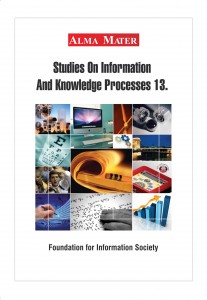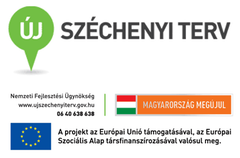-

Cím:
Studies on information and knowledge processes 13.Kiadó:
InfotaKiadás éve:
2008 márciusOldalak száma:
197 -
- Cím:
- Handling risks within projects of Information Technology
- Írta:
- László Wágner
- Oldalszám:
- 7-18
- We go along with that the Information Technology is the one of the most important basic infrastructures of a competitive company. Companies expose themselves to danger if they leave out of consideration the risks of IT. It must to know how handle and mitigate the dangerous treats. We will take a closer look at the steps of reducing risks and some risk measurement techniques. I will emphasize the notability of handling IT risks in portfolio.
-
- Cím:
- Compact document representation method to support quick information retrieval
- Írta:
- Miklós Vázsonyi
- Oldalszám:
- 19-30
- A new compact document representation method is proposed that can support quick information retrieval (IR) with better memory and space requirements then previous methods. The proposed method can represent the term-document (TD) matrix in an efficient way avoiding the sparse matrix problem, can be a substitute of that and on the other hand it is capable of supporting spectral IR methods. The main contribution of the paper is the novel idea of representing textual documents efficiently with the combination of Term Finite State Automaton (Term FSA) and Term Tape in order to support quick document IR preserving term position and term label information. This is a recommendation how to represent a document corpus efficiently before performing IR tasks. Computational complexity experiments and comparisons were performed on reference databases showing the advantages of the proposed method.
-
- Cím:
- Rapid method to unique term extraction and recognition over large document corpuses using finite state automata
- Írta:
- Miklós Vázsonyi
- Oldalszám:
- 31 – 42
- A new method is proposed to perform rapid unique term extraction and recognition over large document corpuses. The new element here is the usage of finite state automata (FSA) to extract, store and recognize unique terms of a large document corpus with a unique node structure and implementation method that avoids the sparse matrix problem. Implementation method is described with source code example regarding how to build the FSA with the proposed new structure. Computational complexity experiments were made on reference databases regarding space consumption and running time requirements showing the advantages of the proposed method.
-
- Cím:
- Market basket analysis and frequent itemset retrieval
- Írta:
- Gábor Szűcs
- Oldalszám:
- 43 – 52
- In this paper the aims of the research of information retrieval are presented, after that the general steps in the procedure of retrieval will be shown. Two research areas are presented in this topic: Market basket analysis and finding frequent itemsets. Both of them can be used in large commercial firms. After the conclusion some possibilities for the further development will be presented.
-
- Cím:
- WebCIR: Web ranking and search engine using combined method
- Írta:
- Sándor Dominich, T. Kiezer, M. Erdélyi
- Oldalszám:
- 53 – 74
- A new method is proposed for the retrieval and ranking of Web pages based on content importance, link importance, and topical similarity. The method is implemented in a search engine called WebCIR. Four measurement methods are used, involving also real users, to evaluate the effectiveness of WebCIR, which is compared to the effectiveness of Altavista, Yahoo!, and MSN. The results show that the method is a very competitive ranking method.
-
- Cím:
- Electronic signature and climate change
- Írta:
- Péter Máté Erdősi
- Oldalszám:
- 75 – 86
- Is there any connection between electronic signature and climate changes? Does the ecological footprint depend on using of electronic signature? The question is dumbfounding. The answer is not known yet. The author’s opinion is that there are lots of advantages of applying electronic signature in corporate processes. The wide use of electronic signature can reduce needs of energy in electronic communication, storing, preserving and archiving documents. This article attempts to explain the related definitions and try to define relationships between electronic signature and climate changes.
-
- Cím:
- Next generation of anonymous web browsers: a bit closer to democracy?
- Írta:
- Gábor Gulyás
- Oldalszám:
- 87 – 100
- In our previous studies we analyzed several anonymous browsers in different aspects and we discovered that these services usually offered preset options in packages, with only a few available options. As a result, users were unable to have an influence on global options. Social networking, collaborative filtering might enlighten some new perspectives regarding enhanced options, increased role of users and might also open the possibility of integrating different services, such as anonymous web browsers and search engines. In this study we analyze the effects of these Web 2.0 compatible features on anonymous browsers and further possibilities.
-
- Cím:
- O & TUMEN, the knowledge-management method of competency-based manager training
- Írta:
- Dr. Erzsébet Noszkay
- Oldalszám:
- 101 – 126
- O & TUMEN, the method of knowledge acquisition and management has crystallised over years of experimentation and application This method is a problem-solving application of integrated experiences, gathered over several years. This segment of knowledge is often more difficult to put into words than the kind that lends itself more willingly to abstract theories and the explicit categories that theories are built of. Therefore, when describing the method it is often restricted to describing how it is actually “done”, which seemed sometimes over simplified, sometimes overly complicated. Hoping that practice (and hence problem-solving) is appreciated as a hidden but persuasive type of knowledge as well as it will be understood why it seemed necessary to share these experiences and invite any comments, open a debate or whatever other kind of feedback that might enrich the subject
-
- Cím:
- Analyses of statistical data from various areas of tourism
- Írta:
- Gergely Kovács – Brigitta Gubik – Viktória Tóth – Anikó Fekete – Zsófia Tóth
- Oldalszám:
- 127 – 158
- Our study is aimed at discussing the main products offered by Hungarian tourism, their development during the last couple of years, and significance within the Hungarian tourism, as well as the possible directions of future development. Presentation of regressive and boosting factors is important to outline a whole picture; we are going to investigate impacts exercised by vacation voucher and vacation right on peoples’ travel appetite and travel destinations.
-
- Cím:
- Tourism and marketing
- Írta:
- Zsuzsanna Borbély – Réka Péterffy – Csilla Schneider – Péter Szilágyi – Róbert G. Zimányi
- Oldalszám:
- 159 – 172
- The goal of this work – “Heritage and promotion” – is to form an overall and comprehensive view about the relation of these two concepts, including today’s challenges that an organisation without appropriate management cannot survive. The connected efficiency issues have also been studied. The financial support options that may have great potencial on the fields of economic or corporate social responsibility (CSR) were examined but they are not yet common in Hungary. Private individuals as well as corporations can do their bits of these responsibilities.
-
- Cím:
- Good and bad graphs
- Írta:
- Orsolya Stifán
- Oldalszám:
- 173 – 192
- This paper deals with charts in a broader sense. Graphical excellence is a current issue as there is a growing need for presenting huge information in a quick, comprehensive and correct way. After giving the context, a short historical overview and covering the major paradigms and principles, selected errors and misleading examples are presented to show the most common mistakes one can make when presenting data in a graphical way.


